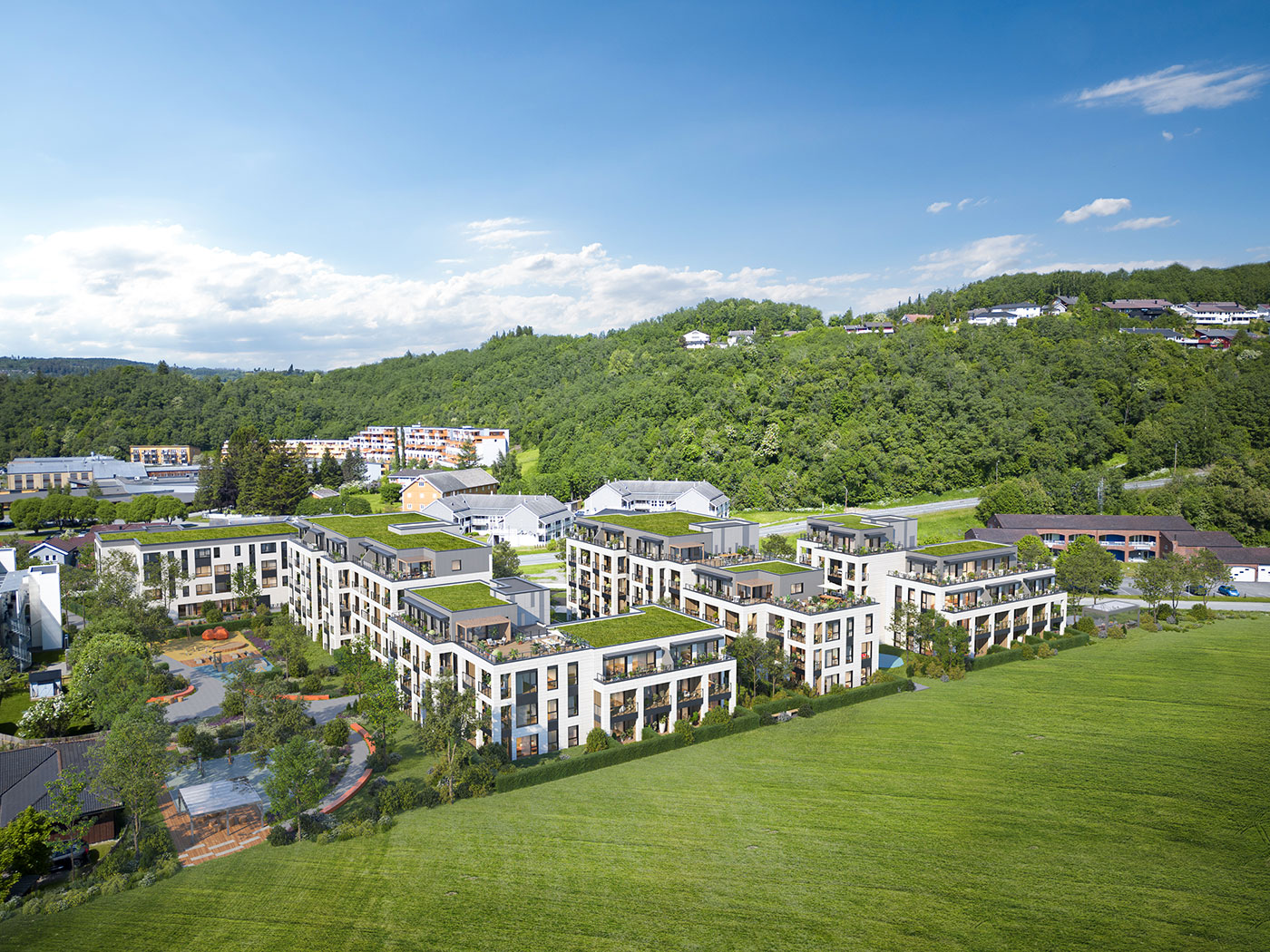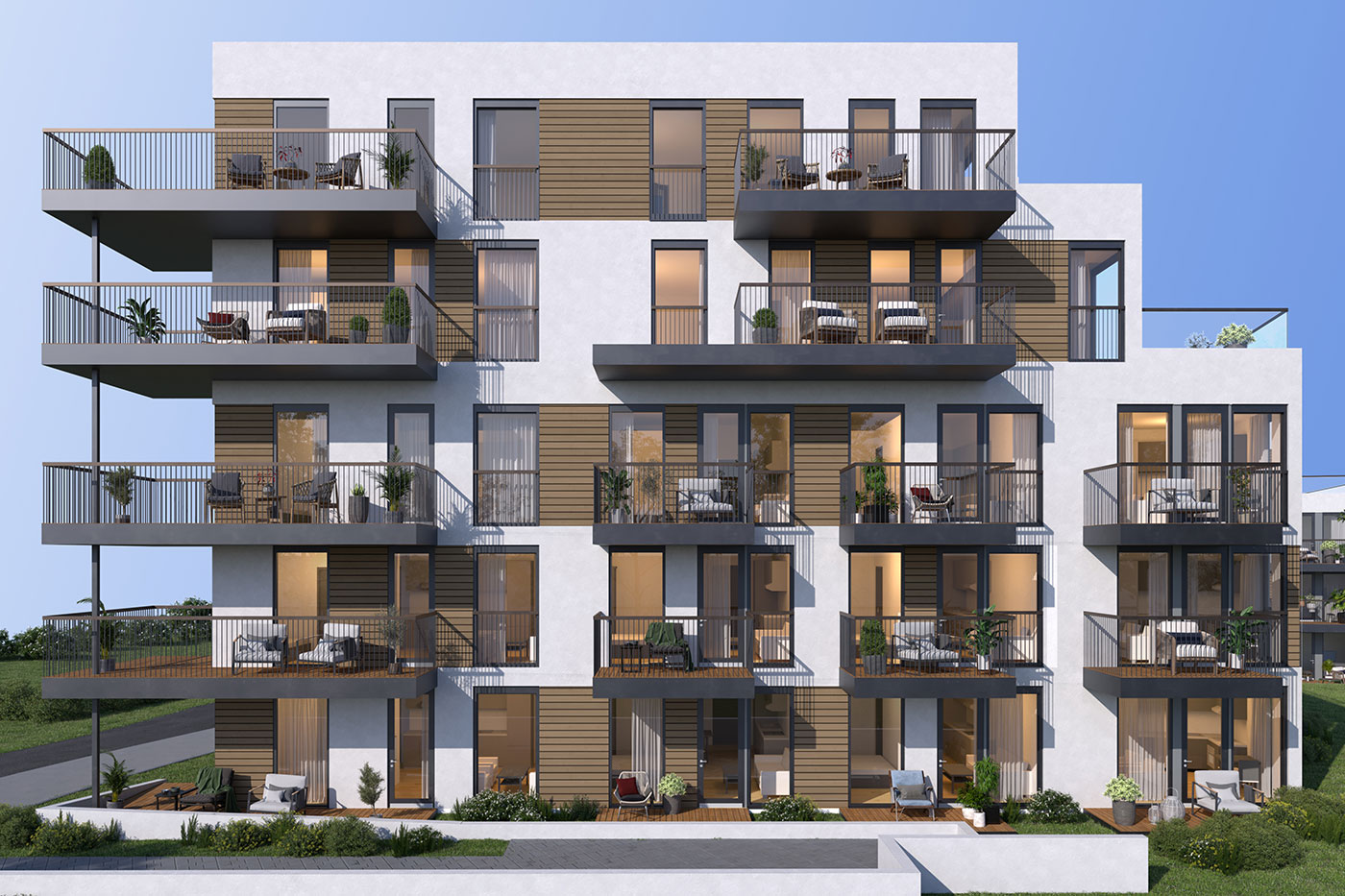Transform Your Space: 10 Innovative Exterior Design Ideas for Modern Homes

Arqsix
March 11th, 2024

Are you intrigued by the idea of transforming your home’s exterior into a stunning work of art? Architectural rendering and innovative exterior design ideas can make your home stand out in your neighborhood, leaving a lasting impression on all who pass by. In this blog post, we will explore cutting-edge exterior design ideas, the impact of 3D rendering, and how technology is shaping the future of modern homes.
We’ll delve into the role of lighting and the integration of sustainable materials in exterior design, providing practical tips for choosing the perfect design for your home. This comprehensive guide will inspire you to reimagine your home’s exterior and elevate it to new heights of visual appeal and functionality.
Key Takeaways
3D rendering has revolutionized exterior design by offering enhanced visualization, streamlined sales processes, and improved client understanding.
Innovative exterior design elements such as sustainable materials, green spaces, and unique architectural features create visually striking homes.
Lighting plays an important role in creating ambiance while security lighting provides a deterrent against intruders. Technology can also be integrated into the design for increased efficiency.
The Impact of 3D Rendering on Exterior Design
 Photo by RF._.studio
Photo by RF._.studio
Architectural rendering, also known as architectural illustration or architectural visualization, has revolutionized the world of exterior and interior rendering design for architectural projects. Gone are the days of relying solely on hand-drawn sketches to visualize a proposed architectural design. Now, architects and clients can use rendering software, such as three-dimensional modeling software, to create realistic renderings, including aerial rendering, that bring their architectural project vision to life through architectural renderings. With design analysis, architects can further refine their architectural design, ensuring the best possible outcome.
3D rendering has significantly impacted the exterior design process, offering enhanced visualization, streamlined sales processes, and increased client appreciation for visualization. We’ll examine these advantages in more depth below.
Enhanced Visualization
3D rendering allows architects and clients to better understand and communicate design ideas, leading to more accurate and efficient project execution. Recent advancements in 3D rendering for exterior design include improved efficiency and productivity, real-time rendering, virtual reality integration, and photorealistic rendering. These cutting-edge technologies enable the creation of photorealistic static images, video walkthroughs, and even immersive 3D virtual reality experiences using real time rendering software.
Enhanced visualization not only benefits architects and designers but also helps clients to better perceive the final outcome of their project. Providing clear and realistic depictions of the proposed design through 3D rendering lessens confusion and promotes effective collaboration between clients and professionals. You can showcase a project from many angles through the power of virtual tours. These can include an aerial view, different lighting and perspectives. Anything to help people see the final proposed architectural design more clearly.
Streamlined Sales Process
The use of 3D renderings, including interior renderings, in the sales process of exterior design projects has significantly optimized the way properties are presented and sold. By offering lifelike representations, potential buyers can envision themselves within the space, boosting their confidence in the decision-making process and leading to faster sales.
3D rendering also speeds up sales in the exterior design industry. It allows for:
the display of advanced architectural plans
correction of errors during the design phase
a more efficient and visually attractive presentation for prospective buyers
This streamlined approach has revolutionized the real estate industry, allowing for more successful property sales aided by 3D exterior rendering.
Client Appreciation for Visualization
As 3D renderings provide a clear and realistic representation of the proposed design, client appreciation for visualization increases, leading to higher satisfaction and trust in the project. By providing lifelike visualizations, clients can collaborate more closely with architects and designers, ensuring a clear understanding of the final outcome.
Incorporating 3D rendering into the construction process results in:
Smoother transactions
More contented clients
Expedited approval
Enhanced communication
The ability to promptly identify mistakes
In short, the benefits of 3D rendering in exterior design extend far beyond aesthetics, fostering a better overall experience for both clients and professionals alike.
Innovative Exterior Design Elements
 Created by Arqsix
Created by Arqsix
Innovative exterior design elements can include sustainable materials, green spaces, and unique architectural features that contribute to a modern and eco-friendly home. By embracing these innovative elements, homeowners can create visually striking exteriors that stand out while also being environmentally conscious.
We’ll further examine these innovative exterior design elements and how they can morph your home’s exterior into a stunning and eco-friendly marvel.
Sustainable Materials
Sustainable materials, such as reclaimed wood or recycled metal, can be used in exterior design to reduce environmental impact and create a unique aesthetic. The use of sustainable materials allows homeowners to save natural resources, cut down on waste, and construct more energy-efficient residences.
Beyond environmental advantages, sustainable materials also give a unique visual charm to the exterior design, infusing the home with character and allure. Some examples of sustainable materials that can be incorporated into your exterior design project include:
Cob
Recycled steel
Sheep’s wool
Low-VOC paint
The possibilities are endless when it comes to using sustainable materials in your exterior design.
Green Spaces
Green spaces, like rooftop gardens or vertical gardens, can be incorporated into exterior design to improve air quality, reduce energy consumption, and provide a natural oasis for homeowners. Innovative green space designs can include green zones on terraces, balconies, or front yards, as well as manicured landscaping and stately patios in the backyard.
Creating private green spaces that blur the line between the interior and exterior of the home not only enhances the visual appeal of the property but also promotes a healthier and more sustainable lifestyle.
Why not think about incorporating green spaces into your exterior design to enjoy the perks of a personal outdoor haven?
Unique Architectural Features
Unique architectural features, such as cantilevered structures or unconventional shapes, can be used to create a visually striking and memorable exterior design. These features add personal touches to the property and can greatly enhance its curb appeal and overall appearance.
Cantilevers, for example, can create awe-inspiring architectural features like balconies, overhangs, and suspended living spaces, augmenting exterior design and providing additional functional space. Incorporating unique architectural features into your home’s exterior design allows for the creation of a genuinely unique and memorable visual impression.
The Role of Lighting in Exterior Design
 Created by Arqsix
Created by Arqsix
The role of accurate lighting in exterior design is crucial for creating ambiance, highlighting architectural features, and ensuring security. Proper lighting can make a significant impact on the quality of the finished product and the overall perception of a space or building.
In the sections below, we’ll examine the different types of lighting used in exterior design and their role in crafting a visually attractive and secure outdoor area.
Ambient Lighting
Ambient lighting provides general illumination for the exterior of a home, creating a welcoming and comfortable atmosphere. This can be achieved through:
Outdoor wall lights
Post lights
Bollard lights
Other fixtures that spread light throughout the area
Careful positioning of ambient lights can highlight architectural features, establish visual points of interest, and enhance the general appeal of your home. Moreover, ambient lighting can make the outdoor area more welcoming and secure, enabling you to enjoy your exterior space even at night.
Accent Lighting
Accent lighting is used to highlight specific architectural features or landscaping elements, adding depth and visual interest to the exterior design. Examples of accent lighting in exterior design include uplighting to emphasize certain architectural features or landscaping elements, illuminating the garage or gables, and lighting up the driveway.
Incorporating accent lighting into your exterior design can spotlight your home’s most remarkable features and cultivate a visually attractive and welcoming ambiance.
Security Lighting
Security lighting, such as motion-activated lights or floodlights, helps to deter potential intruders and ensure the safety of the home’s occupants. Security lighting, by raising the likelihood of intruders being detected and brought to justice, offers psychological deterrence against possible break-ins.
In addition to deterring intruders, security lighting can also provide early warning of any attempted break-ins, allowing homeowners to take appropriate action to protect their property. Integrating security lighting into your exterior design helps safeguard your home and its inhabitants.
Integrating Technology into Exterior Design
 Generated by SurferAI
Generated by SurferAI
Integrating technology into exterior design can enhance functionality, energy efficiency, and overall aesthetics. By leveraging technology, architects and designers are able to push the boundaries of what is possible in exterior design, creating stunning and innovative facades that leave a lasting impression.
Next, we’ll look at how technology can be smoothly integrated into exterior design via smart home integration, solar panels, and advanced building materials.
Smart Home Integration
Smart home integration allows homeowners to control various aspects of their exterior design, such as lighting or security systems, through a centralized app or voice commands. This technology not only improves the exterior functionality but also boosts the overall curb appeal and value of the home.
Incorporating smart home technology into your exterior design can improve the safety, security, and accessibility of your outdoor areas, leading to a more seamless and user-friendly experience.
Solar Panels
Solar panels can be incorporated into the exterior design to generate clean energy, reduce utility costs, and contribute to a sustainable lifestyle. Solar panels, by harnessing solar power, offer a viable, renewable, and inexhaustible energy source. This reduces dependence on fossil fuels and cuts down greenhouse gas emissions.
In addition to the environmental benefits, solar panels can also lower electricity bills and provide energy independence, promoting a more sustainable and self-sufficient lifestyle. Thus, integrating solar panels into your exterior design is not only an eco-friendly choice but also a smart investment in your home’s future.
Advanced Building Materials
Advanced building materials, like self-cleaning surfaces or energy-efficient insulation, can be used to improve the performance and durability of a home’s exterior. These innovative materials offer a range of benefits, such as increased structural integrity, enhanced energy efficiency, and reduced environmental impacts.
Incorporating advanced building materials into your exterior design can offer the following benefits:
Visually pleasing appearance
Increased durability
High performance
Long-term peace of mind
Tips for Choosing the Right Exterior Design for Your Home
 Created by Arqsix
Created by Arqsix
Choosing the right exterior design for your home involves assessing your needs, setting a budget, and consulting with professionals. By taking these factors into consideration, you can make informed decisions that ensure the success of your exterior design project.
In the next sections, we’ll examine each of these tips more closely, guiding you in crafting the ideal exterior design for your home.
Assessing Your Needs
The choice of an exterior design for your home should take into account factors like climate, lifestyle, and personal preferences. Climate plays an essential role in determining the most suitable exterior design elements, impacting factors such as structural integrity, materials selection, and energy efficiency.
Additionally, your lifestyle and personal preferences will greatly influence the overall look and feel of your exterior design. By taking the time to assess your needs and preferences, you can create an exterior that is both visually appealing and tailored to your unique requirements.
Taking inspiration
This step is completely optional, however if you want the exterior and interior of your dreams to come true, it's best if you take some time to get inspired. The professionals or artists you decide to hire will highly appreciate any additional detail you can tell them about your project. Even a single image or a moodboard can help them illustrate design ideas that are closer to your expectations.
Setting a Budget
Establishing a budget for your exterior design project is vital to keep it financially viable and to help you prioritize the most significant features. Establishing a budget involves considering factors such as the cost of materials, labor costs, and the overall project objectives.
By setting a realistic budget and sticking to it, you can ensure that your exterior design project is completed on time and within your financial means, allowing you to enjoy the results without breaking the bank.
Consulting with Professionals
Lastly, consulting with professionals, like architects or landscape designers, is advisable when planning your exterior design project. These experts can provide valuable insights and guidance to help you achieve your desired exterior design, ensuring that your project is both visually appealing and functional.
By working closely with professionals and leveraging their expertise, you can create an exterior design that not only meets your needs and preferences but also stands the test of time, providing you with a beautiful and enduring outdoor space to enjoy for years to come.
Summary
In conclusion, the world of exterior design and architectural rendering is full of exciting possibilities. By embracing innovative design elements, integrating technology, and utilizing advanced building materials, homeowners can create visually striking exteriors that are both functional and environmentally friendly.
By assessing your needs, setting a budget, and consulting with professionals, you can ensure that your exterior design project is a success. So, whether you’re looking to revamp your existing home or design a new one, these tips and insights will help you create a stunning and sustainable exterior that leaves a lasting impression on all who see it.
Frequently Asked Questions
When it comes to architectural design and rendering software there are plenty of questions you might want to ask. We are here to answer the most common ones, however, we are only a message away if you would like to send us an inquiry.
FAQs
Our location
Ready to share your expertise?
We welcome submissions from talented writers and experts in various fields who are passionate about sharing their knowledge and insights with our audience.
Write for UsArqsix - Shaping Stories, Shaping Spaces
Elevating real estate marketing for a world that’s always evolving.
2025 © Arqsix. All Rights reserved. |Sitemap|Privacy Notice